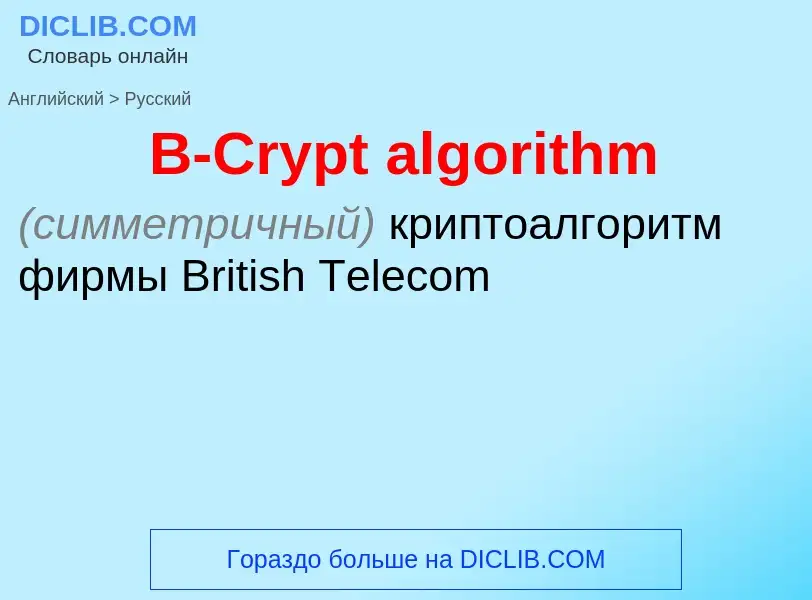أدخل كلمة أو عبارة بأي لغة 👆
اللغة:
ترجمة وتحليل الكلمات بواسطة الذكاء الاصطناعي
في هذه الصفحة يمكنك الحصول على تحليل مفصل لكلمة أو عبارة باستخدام أفضل تقنيات الذكاء الاصطناعي المتوفرة اليوم:
- كيف يتم استخدام الكلمة في اللغة
- تردد الكلمة
- ما إذا كانت الكلمة تستخدم في كثير من الأحيان في اللغة المنطوقة أو المكتوبة
- خيارات الترجمة إلى الروسية أو الإسبانية، على التوالي
- أمثلة على استخدام الكلمة (عدة عبارات مع الترجمة)
- أصل الكلمة
B-Crypt algorithm - ترجمة إلى الروسية
ALGORITHM THAT COMPUTES THE GREATEST COMMON DIVISOR OF TWO INTEGERS USING ONLY ARITHMETIC SHIFTS, COMPARISONS, AND SUBTRACTION
Binary gcd algorithm; Binary gcd; Knuth's algorithm B; Stein's Algorithm; Binary Euclidean algorithm; Stein's algorithm
B-Crypt algorithm
(симметричный) криптоалгоритм фирмы British Telecom
algorithm
SEQUENCE OF INSTRUCTIONS TO PERFORM A TASK
Algorithmically; Computer algorithm; Properties of algorithms; Algorithim; Algoritmi de Numero Indorum; Algoritmi de numero indorum; Algoritmi De Numero Indorum; Алгоритм; Algorithem; Software logic; Computer algorithms; Encoding Algorithm; Naive algorithm; Naïve algorithm; Algorithm design; Algorithm segment; Algorithmic problem; Algorythm; Rule set; Continuous algorithm; Algorithms; Software-based; Algorithmic method; Algorhthym; Algorthym; Algorhythms; Formalization of algorithms; Mathematical algorithm; Draft:GE8151 Problem Solving and Python Programming; Computational algorithms; Optimization algorithms; Algorithm classification; History of algorithms; Patented algorithms; Algorithmus
algorithm noun math. алгоритм algorithm validation - проверка правильности алгоритма
algorithmic method
SEQUENCE OF INSTRUCTIONS TO PERFORM A TASK
Algorithmically; Computer algorithm; Properties of algorithms; Algorithim; Algoritmi de Numero Indorum; Algoritmi de numero indorum; Algoritmi De Numero Indorum; Алгоритм; Algorithem; Software logic; Computer algorithms; Encoding Algorithm; Naive algorithm; Naïve algorithm; Algorithm design; Algorithm segment; Algorithmic problem; Algorythm; Rule set; Continuous algorithm; Algorithms; Software-based; Algorithmic method; Algorhthym; Algorthym; Algorhythms; Formalization of algorithms; Mathematical algorithm; Draft:GE8151 Problem Solving and Python Programming; Computational algorithms; Optimization algorithms; Algorithm classification; History of algorithms; Patented algorithms; Algorithmus
математика
алгоритмический метод
ويكيبيديا
Binary GCD algorithm
The binary GCD algorithm, also known as Stein's algorithm or the binary Euclidean algorithm, is an algorithm that computes the greatest common divisor of two nonnegative integers. Stein's algorithm uses simpler arithmetic operations than the conventional Euclidean algorithm; it replaces division with arithmetic shifts, comparisons, and subtraction.
Although the algorithm in its contemporary form was first published by the Israeli physicist and programmer Josef Stein in 1967, it may have been known by the 2nd century BCE, in ancient China.


![Alan Turing's statue at [[Bletchley Park]] Alan Turing's statue at [[Bletchley Park]]](https://commons.wikimedia.org/wiki/Special:FilePath/Alan Turing.jpg?width=200)




